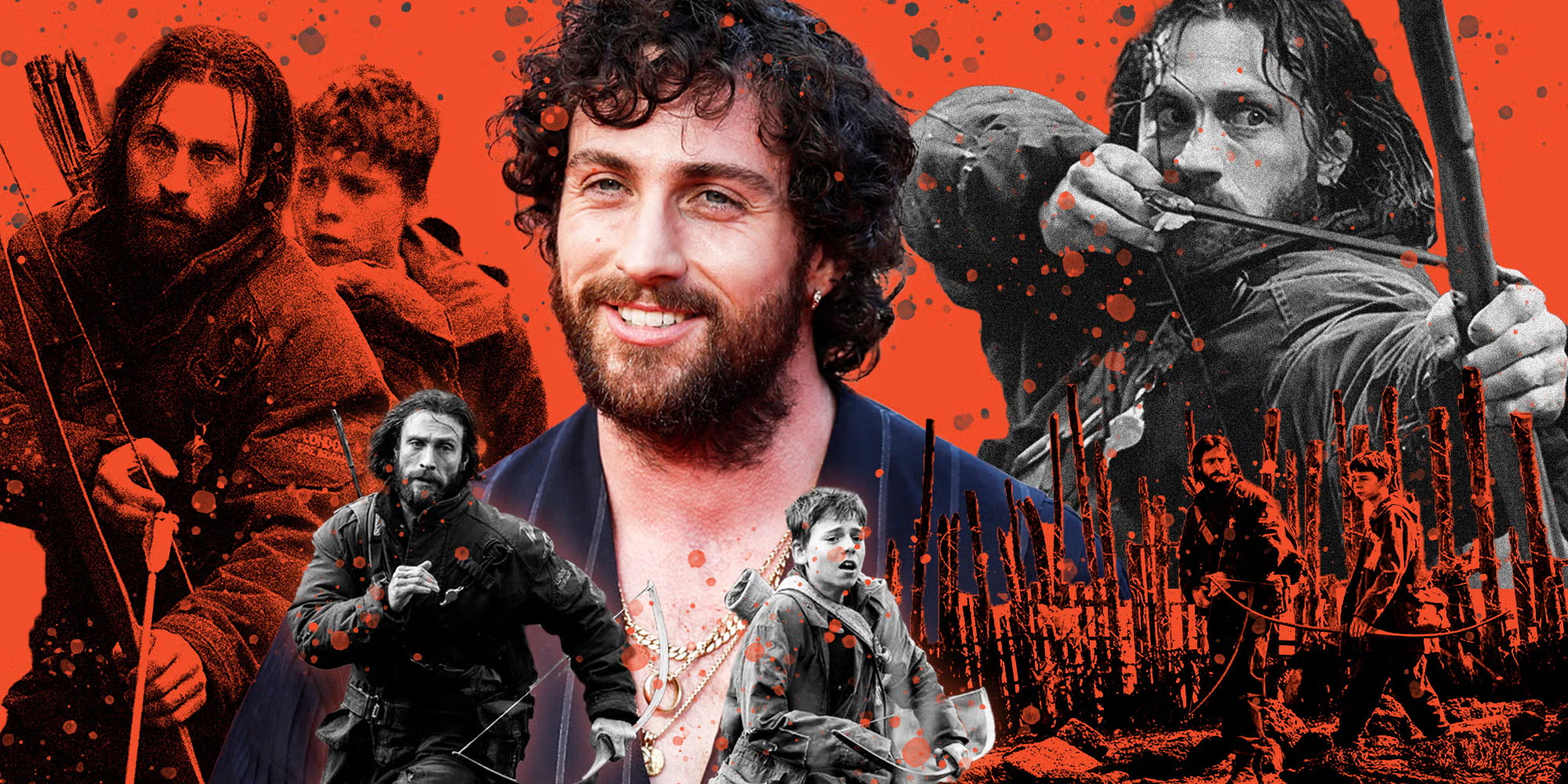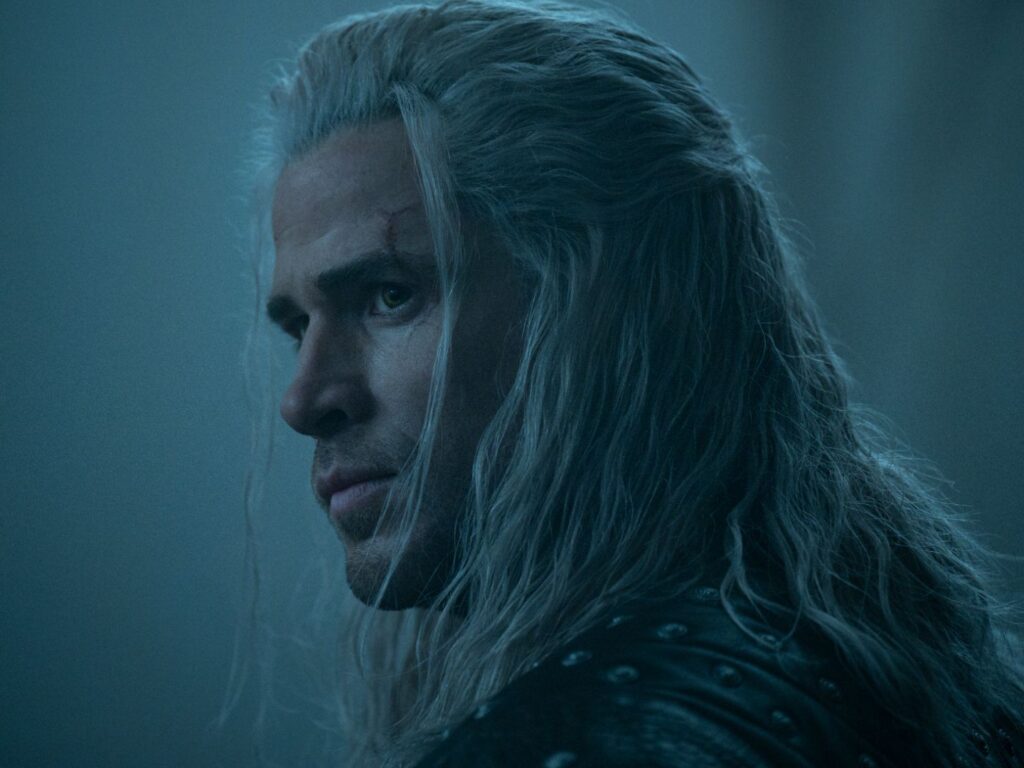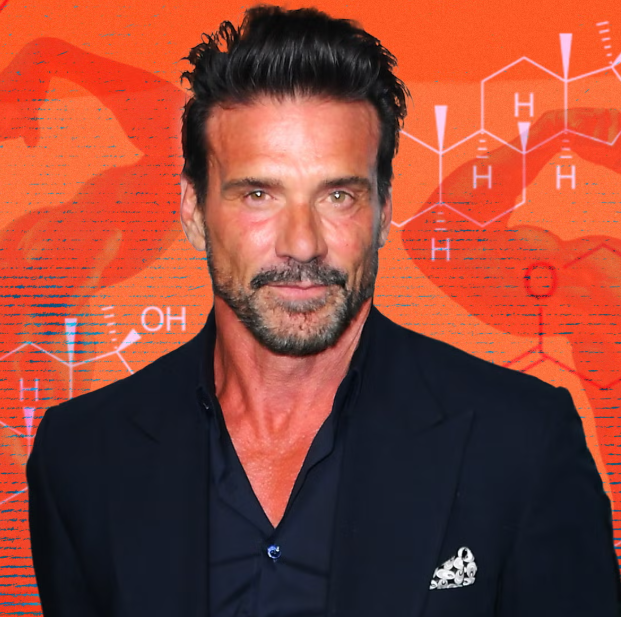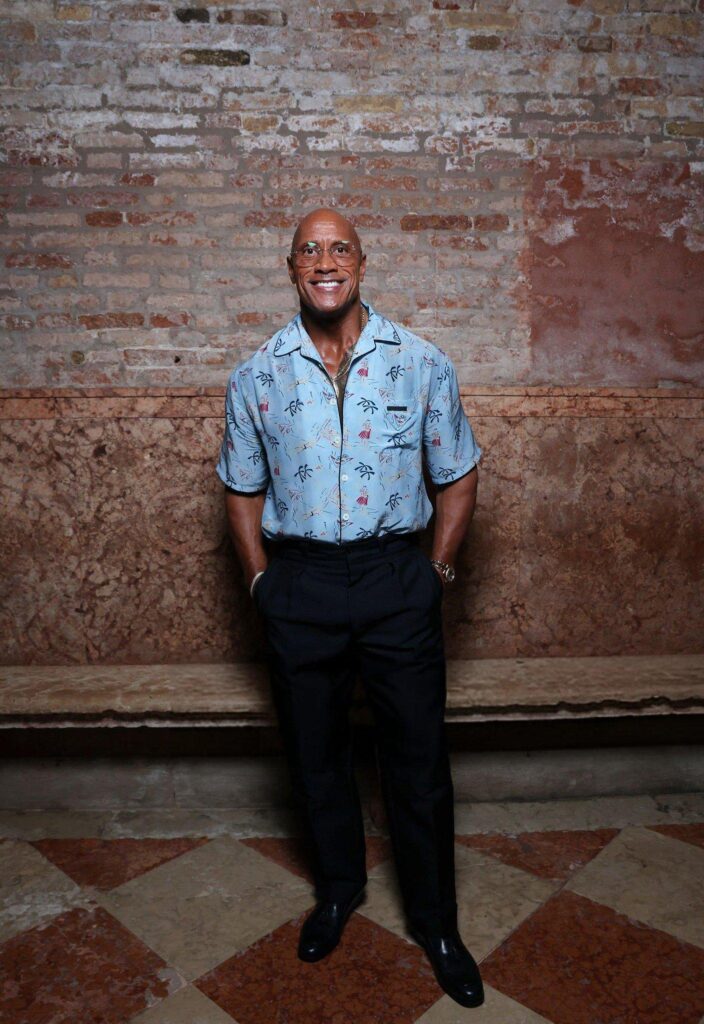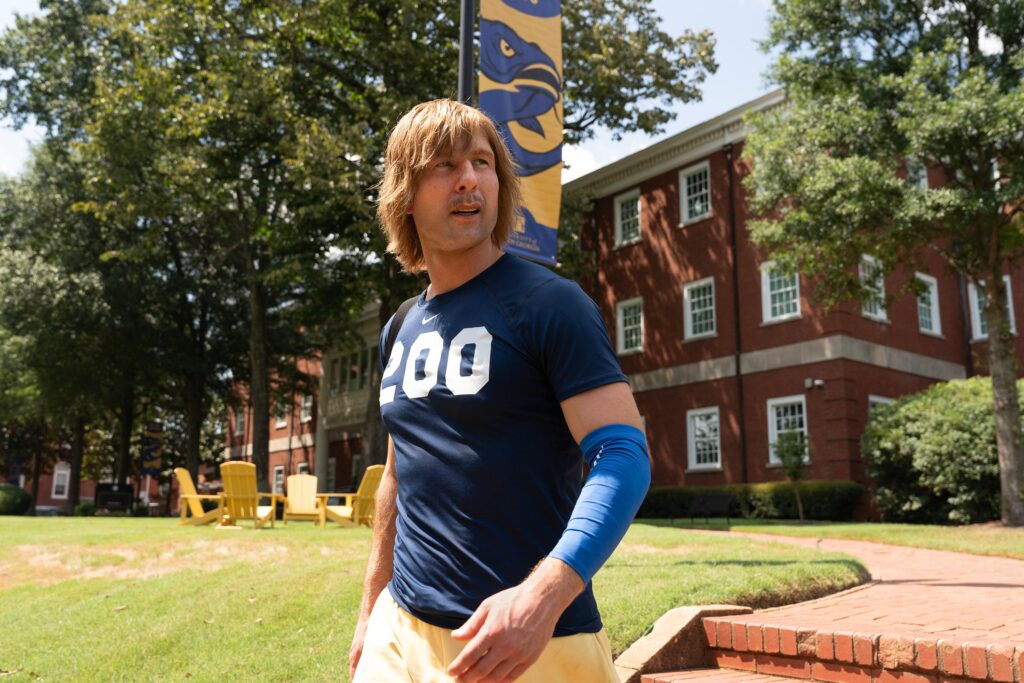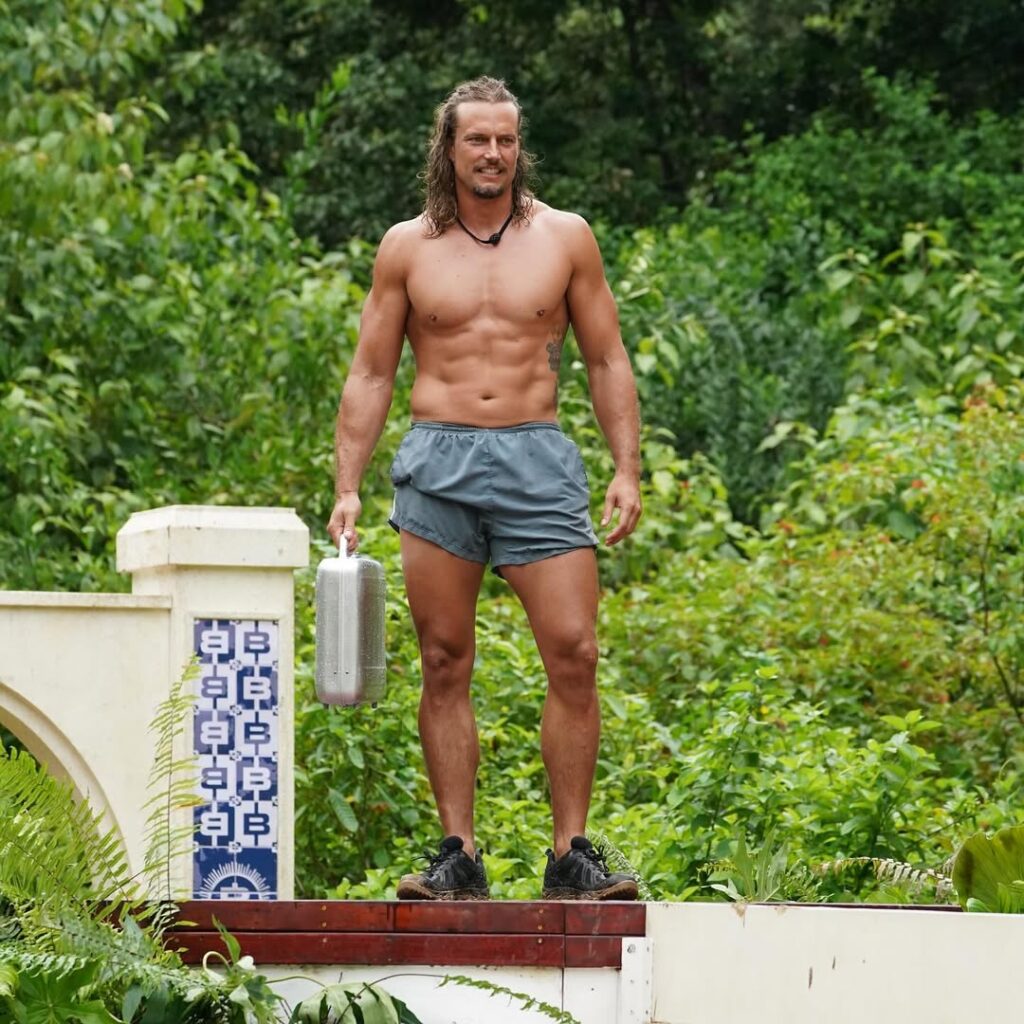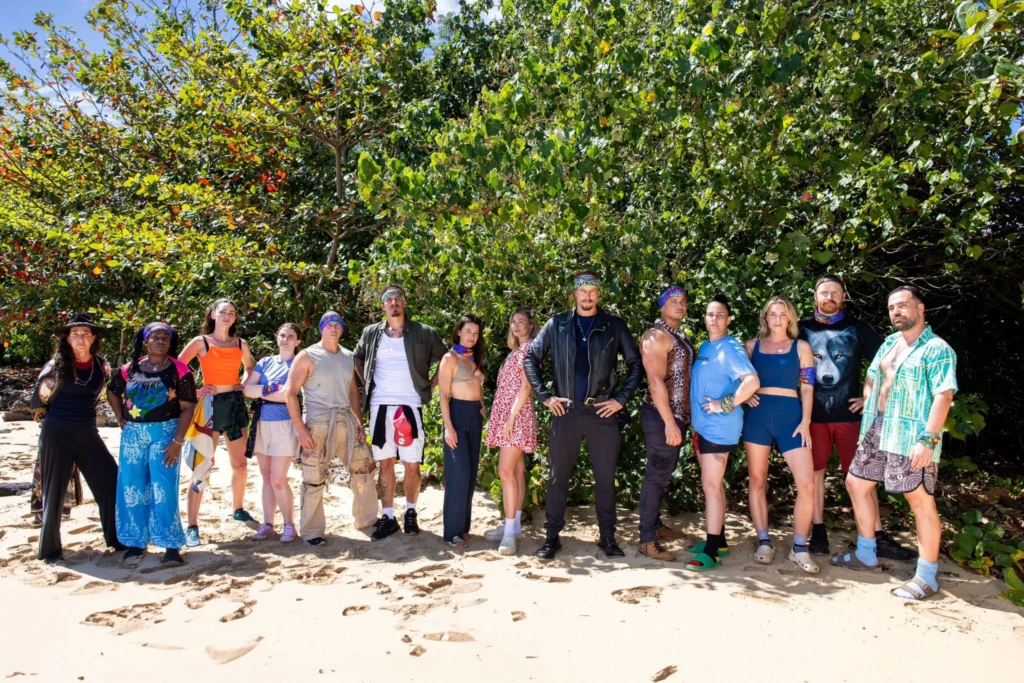IF THERE’S ONE thing Aaron Taylor-Johnson has made clear on screen through the years, it’s that he’s a born survivor. That’s never been more evident than in Danny Boyle’s new horror-thriller 28 Years Later, though the complex and flawed characters he’s played have often struggled to adapt to the difficult circumstances they’ve been dealt in each given doomsday scenario.
Consider Taylor-Johnson’s ill-fated entrepreneur in Robert Eggers’s Nosferatu, in complete denial of the threat posed by the supernatural. There’s also the emotionally wounded Navy lieutenant who literally jumped into battle against monsters in Gareth Edwards’s 2014 Godzilla film. Even in superhero movies, where Taylor-Johnson has long been gainfully employed—from his scrappy lead role in Kick-Ass and its sequel to his more domineering performance in Kraven the Hunter and short sprint of a stint as Quicksilver in the Marvel Cinematic Universe—his characters have always skewed darker, wrestling with their own demons alongside external threats.

“He definitely comes from a place of trauma, and he’s pushed a lot down,” Taylor-Johnson tells Men’s Health of his latest brooding hero, 28 Years Later‘s Jamie. A conflicted father whose survivalist way of life is a learned response to the horrors he’s experienced in the years since a “rage virus” decimated the U.K., Jamie is “very repressed, and also coming from a place of fear,” he adds.
In fairness, Boyle—who re-teams with writer Alex Garland and cinematographer Anthony Dod Mantle to follow up 28 Days Later, their landmark 2002 original—has given him plenty to be afraid of. Set decades after the initial outbreak turned infected humans into relentless hordes, 28 Years Later depicts the British mainland as a post-apocalyptic state. Continental Europe enforces a quarantine that has forced survivors to form cloistered communities, rebuilding society away from the world. Off England’s northeast coast, one such community—known as Holy Island—has effectively sealed itself in; protected by a fortified causeway that’s only passable at low tide, the islanders work together to keep the infection out.
Only a select few, like Taylor-Johnson’s Jamie, venture to the mainland to scavenge for supplies, despite the danger posed by smarter, stronger mutations of the infected. This is a physically and emotionally demanding role to play in the community, but Jamie’s a hardened survivalist—especially because, with his young son Spike (Alfie Williams) and ailing wife Ilsa (Jodie Comer) at home, he has a family to protect. But after he brings Spike to the mainland, determined to give him the tools and training he’ll need to survive in a harsh world, Jamie’s tight bond with his son becomes frayed, setting in motion the events of Boyle’s larger trilogy.

Taylor-Johnson is already confirmed to reprise the role of Jamie in 28 Years Later: The Bone Temple, which was shot back-to-back with its predecessor and is set for release this coming January; a third film is in development to conclude the series, though Taylor-Johnson is keeping anything he might know about his future with the franchise under lock and key.
In an interview with Men’s Health, the actor reflected on the experience of teaming up with Boyle, what 28 Years Later has to say about masculinity, and the difficulty of working with bows and arrows on set.
MEN’S HEALTH: Your character in this film belongs to a community of survivors, isolated from the mainland. Jamie has adopted a survivalist’s mindset in his years there, in addition to accruing acumen with a bow and arrow. How did you approach the psychology of a character like this?
AARON TAYLOR-JOHNSON: There’s quite a physicality to this character, and he’s found solace in this community. They’ve all got a role to play, and he’s found a purpose—he’s someone who can go to the mainland, fetch wood, hunt deer, bring food back, and be a warrior. He’s there to kill the infected.
When you see him, he’s taken his son, for the first time, to the mainland to teach him everything he knows about navigating and surviving in this post-apocalyptic world. They’ve reverted back to old techniques—bow and arrow is the way they’re going to do things, because ammunition runs out, and you can no longer get hold of anything like that. They’ve had to find new ways of doing stuff. They don’t want to get too close or tactile; they’re not using any knives. They’re keeping a distance. Bow and arrow seems to be the way they’ve been able to survive.
MH: Jamie guiding his son through this rite of passage sets the entire trilogy in motion. How did you dial into this fraught father-son dynamic, and what can you say about the appeal of seeing that dynamic evolve across multiple films?
ATJ: He takes his son out to teach him how to kill the infected and how to dehumanize them. It’s very much a separation—an “us versus them” scenario—and that’s the premise that plagues his son. His son’s moral compass, then, is a question of, “Is this what life is? Or is there more to life than this?” That’s when he starts to ask questions my character isn’t emotionally equipped to answer. He fails him as a father, and reacts in a way that’s coming from a place of fear.
It’s a really beautiful coming-of-age story that you see through the eyes of this 13-year-old boy. It was also very physical—both of us had to learn how to do archery, which was fantastic. And, obviously, films like this involve a lot of running, because you’re getting chased by the infected.

MH: What physical training did this role require, particularly in terms of working with bows and arrows? It’s not simply target practice—you’re running, shifting into defensive postures, and shooting arrows back at the infected as they run after you.
ATJ: You can learn archery by standing in a line, loading up your bow, and taking shots at a target. But once you start to put that into movement—once you’re running and trying to find some place to hide behind a tree, and you’re grabbing the next arrow, firing it, then running again—it becomes a lot trickier and more dynamic.
When you’re making a film, safety is always the most important element. One of the main challenges was that we couldn’t actually have our arrows nocked. They couldn’t actually be propelled backwards; We couldn’t actually be firing arrows on set, with crew members and other actors around. That element, by itself, was challenging—when it gets released, the arrow itself has to become a special effect. You’re still grabbing arrows and loading up, but the arrow itself ends up just falling down. That challenge is a weird one, because you’re having to not feel silly when you know that it’s just fallen to the side. [Laughs]
My character’s son is played by Alfie Williams, who’s phenomenal. He’s only 13, and it was quite brilliant for me to see his brain switch into that [mode,] because he was fantastic at archery. He was hitting bullseyes, but when he got to set he realized he couldn’t nock arrows into the bowstring. Instead, you have to squeeze it between your fingers and pull it in a way that doesn’t feel real—but you have to still make it feel effective and real. That’s when the performance element comes into play, and you allow that to be the challenge on the day.
MH: 28 Days Later captured this contagion of social rage, which feels linked to the anger Jamie and Spike share in their grappling for control over both their masculine identities and their struggle to help Isla. Jamie carries quite a lot of anger, and it complicates his relationship with both of them.
ATJ: Absolutely. With this role he has in his community, Jamie feels that he’s found control and purpose. When his son starts asking questions he’s in denial about—with regard to his wife’s condition, for instance—he doesn’t know how to answer. He doesn’t know how to react in a smart way, and that’s when he falls apart. That’s when he loses it. He’s flawed, and he makes a mistake they might never come back from— one that’s going to haunt him.
This film does say a lot about masculinity—in that sense, and even just in parenthood. I felt very paternal over Alfie. Obviously, the roles are father-son roles, and I’m a father. I’m the father of four girls, and we as parents really put a lot onto our kids and project a lot of our own issues onto them. Sometimes, you’ve got to realize that and actually know that they themselves, as children, have their own voice and opinion, and that they have to learn and experience for themselves what they feel about a situation.
Evolving as he does in that way, Spike ends up growing more than his father does—and maybe, at some point, he can teach him that. But we’ll see…
MH: Danny Boyle is an endlessly inventive filmmaker; he’s attaching cameras to actors, shooting sequences on iPhones, designing special 20-camera rigs. What does that bring out in an actor?
ATJ: Every day was an absolute blessing, and an experience I’ve never had with any other director. Firstly, Danny Boyle is wonderful; He has this incredible enthusiasm and energy. But you’d come onto set, and these camera rigs we were using were brand-new. Even for the crew, it was very experimental, and sometimes Danny would come out and say, “I don’t know if this is gonna work, but we’re gonna give it a try.”
That felt really refreshing, because it meant everything we were doing allowed for these happy accidents and mistakes, and with those happy accidents and mistakes, you were discovering more things you liked. It felt very playful on set, which allowed for different nuances to happen.
When you watch this movie back, too, you feel the correlation between this and 28 Days Later, which was filmed on a camcorder. Now, he’s evolving to the iPhone, and it gives [the film] that same kind of quality: the way it moves, the way it can get very intimate, the way it breaks the mold. When someone sticks an iPhone in your face, it feels very invasive, and you feel quite vulnerable. They can really see you. That quality makes for a different experience when you see it in a cinema. It’s original—completely original.
This interview has been edited and condensed for clarity.
This article originally appeared on Men’s Health US.
Related:




